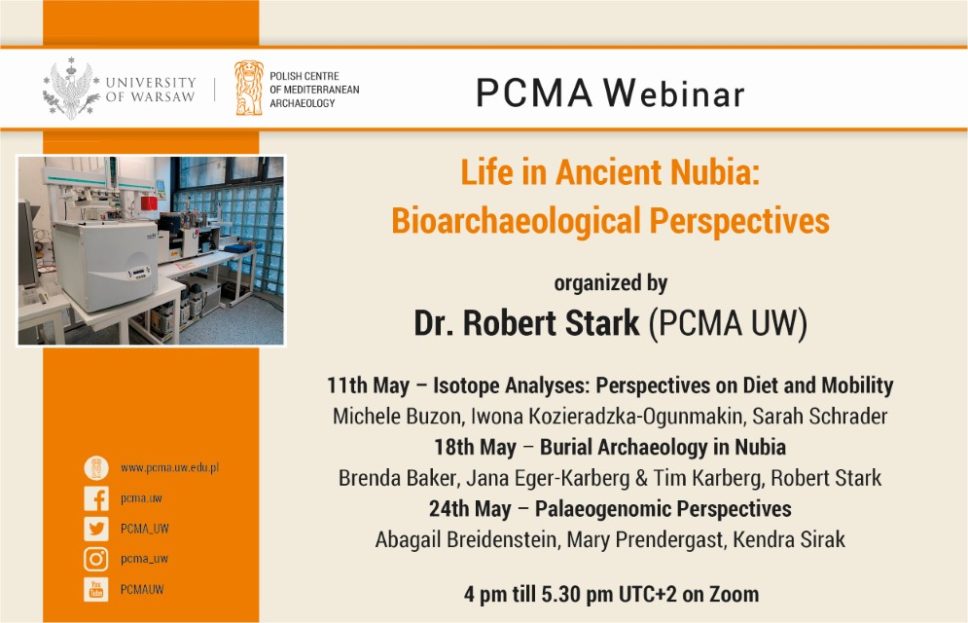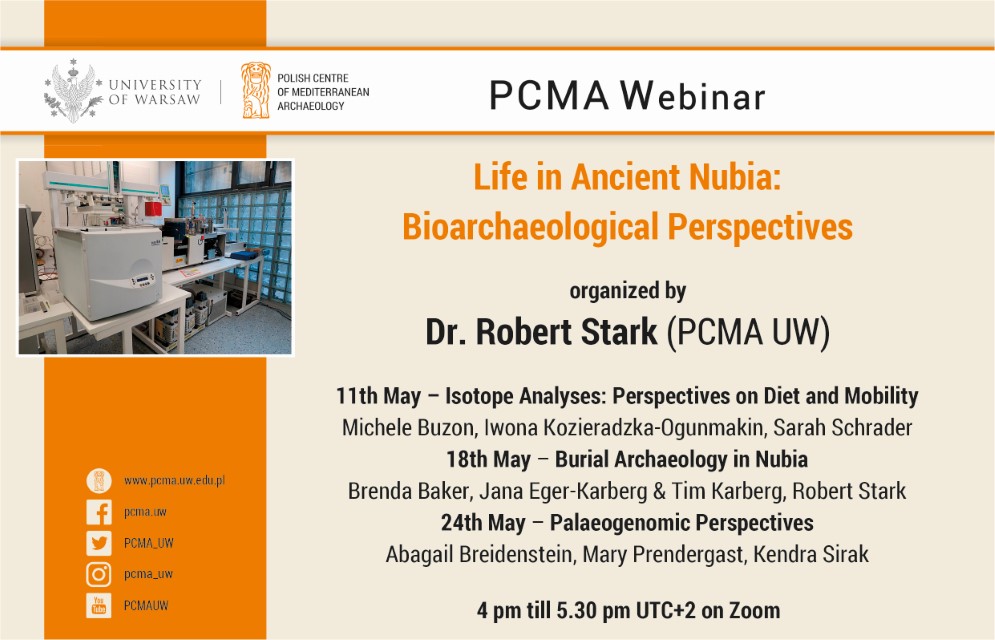W maju tego roku Seminarium PCMA będzie gościć serię prelekcji na temat rozmaitych aspektów badań bioarchaeologicznych nad życiem w starożytnej Nubii. Seria, która będzie odbywać się online przez trzy kolejne tygodnie, jest organizowana przez dr Roberta Starka, który będzie też prowadził wszystkie spotkania w tym cyklu.
Cykl wykładów „Życie w starożytnej Nubii: Perspektywy bioarcheologiczne” prezentuje szereg zagadnień bioarcheologicznych związanych z badaniami nad życiem w starożytnej i średniowiecznej Nubii. Każda sesja skupi się na konkretnym obszarze badań bioarcheologicznych. Referaty pokażą, czego można się dowiedzieć z dokumentacji terenowej oraz eksploracji miejsc pochówku, czego można oczekiwać od analiz izotopowych w kontekście oceny diety i mobilności dawnych populacji, a także jakie możliwości dają badania paleogenomiczne. Łącznie prezentacje z tej serii dadzą wgląd w aktualny obraz badań bioarcheologicznych w kontekście Nubii, wskażą też kierunki przyszłych badań.
Od organizatorów: „Cieszymy się, że mogą Państwo dołączyć do dyskusji na temat badań bioarcheologicznych nad życiem w starożytnej Nubii. Jednak wydarzenia w Sudanie, które trwają od 15 kwietnia, doprowadziły do tragicznej sytuacji ten kraj i jego mieszkańców. Solidaryzujemy się z mieszkańcami Sudanu: z naszymi przyjaciółmi, kolegami i współpracownikami – wystąpienie jednego z nich było zaplanowane w tej serii wykładów – oraz z licznymi społecznościami, w których wielu z nas było ciepło witanych i czerpało wiele radości z możliwości prowadzenia tam badań. Wzywamy strony zaangażowane w konflikt do zakończenia walk i mamy nadzieję na szybkie i przywrócenie spokoju. Mamy nadzieję, że rozpowszechnianie informacji o wynikach naszej pracy może przyczynić się do podniesienia świadomości na temat dziedzictwa kulturowego Sudanu oraz potrzeby wspierania przez społeczność międzynarodową działań na rzecz pokoju i stabilności w tym kraju.
Myślami jesteśmy z mieszkańcami Sudanu.”
Czwartek, 11 maja (16:00 do 17:30) – „Isotope Analyses: Perspectives on Diet and Mobility”
- Michele Buzon, Purdue University:
„Bioavailable Strontium in the Nile Valley: Variation across Time and Space”
Abstract: „This presentation will report on newly gathered strontium isotope data from human, animal, and botanical sources from sites in Sudan combined with previously published data from the Nile Valley region. The idea that strontium values have changed over time due to increased contribution of aeolian material from the neighboring Sahara Desert associated with climate change is not supported by these data. Values differ at sites, though much overlap is apparent. Neodymium and lead isotopes are introduced as a way to evaluate diagenesis in the strontium samples.”
- Iwona Kozieradzka-Ogunmakin, Centrum Archeologii Śródziemnomorskiej UW:
„Isotopic evidence of an environmental shift at the fall of the kingdom of Meroe (c. 300 BCE–350 CE)”
Abstrakt: „Previously investigated factors that led to the collapse of the Meroitic kingdom (c.300 BCE–350 CE) in the Middle Nile Valley include socio-political and economic instability, whereas recent studies focus on potential contribution of the environmental factors, investigated through the application of isotopic studies. This presentation will discuss results of stable carbon and oxygen isotope analysis of human and animal dental enamel from 13 archaeological sites located between the First Nile Cataract and the Blue Nile. The obtained isotopic data are suggestive of an environmental shift towards more arid conditions that likely contributed to the fall of the Meroitic kingdom.
*Prezentacja jest oparta na artykule, który został już przyjęty do druku: Kozieradzka-Ogunmakin, I. & Sołtysiak, A. (w druku). Isotopic evidence of an environmental shift at the fall of the Kushite kingdom of Meroe, Sudan. Antiquity.
- Sarah Schrader, Leiden University:
„Isotopic Approaches to Dietary Reconstruction in Bronze Age Nubia”
Abstrakt: „Carbon and nitrogen isotopes can be used to broadly infer dietary practices in the past. Here, I review previous research and present new isotopic data from multiple Bronze Age sites in ancient Nubia. These data suggest a varied diet for ancient Nubians that may have been dependent upon cattle as a food resource. I also discuss how the analysis of multiple tissues (e.g., hair, fingernails, bone) can be advantageous when reconstructing ancient foodways.”
Czwartek, 18 maja (16:00 o 17:30) – „Burial Archaeology in Nubia”
- Brenda Baker, Arizona State University:
„Recent Research from the ASU Bone Project”
Abstrakt: „Fieldwork in the area of al-Qinifab, on the north bank of the Nile River west of Abu Hamad, produced a sample of 50 individuals from five Kerma to Napatan sites, and 100 individuals from the late Meroitic to Christian period at the Qinifab School site. Recent research is summarized, including evidence for grave re-entry to retrieve objects as part of the mortuary rite and decreasing mobility measured by strontium isotope ratios through the Kerma period. At the Qinifab School site, analysis indicates an increase in violent trauma in the Christian period, coinciding with a shift in the organization of the cemetery and in diet.”
- Jana Eger-Karberg and Tim Karberg, University of Münster:
„Tumuli and box graves of the central Bayuda – cultural, religious, and astronomical aspects”
Abstrakt: „In the Wadi Abu Dom Bayuda, a lot of cemeteries consisting of tumuli and box graves were investigated by a research project of the University of Muenster between 2009 and 2016. Analysed by GIS, the topographical orientations of these different grave superstructures seems highly significant. In some cases, younger specimens seem to be aligned to older ones, but also (folk) astronomical contexts seem to play some role. In this contribution, the cultural and religious significance of the orientation and alignment of these different burial types as well as astronomical aspects and the geo-statistical methods to investigate them are to be discussed.”
- *Mahmoud Suliman Bashir, National Corporation for Antiquities and Museums, Regional Director of Antiquities – River Nile State; Resident Manager of the Island of Meroe World Heritage Site:
„The Kushite Cemetery at Berber Comments on Skeletons Preliminary Studies”
Abstrakt: „Physical anthropological study of the human remains from Berber was established under the umbrella of Amara West Workshop for Physical Anthropology in 2011; however, the well preserved skeletons from Berber encouraged some colleagues to initiate the Bio-archaeology of Berber Meroitic Cemetery Project at that time. Berber cemetery is unique because of the extraordinary good condition and well preservation of bones. In fact, all skeletons were at least 90% complete and in several cases, considerable amounts of hair and other soft tissues were preserved as well. The fact create great research potential that can provide good result in the field of bio-archaeology.”
*wystąpienie przełożone na późniejszy termin
- Robert J. Stark, PCMA UW:
„Burial Archaeology at Old Dongola: Bioarchaeological Insights:
Abstrakt: „Located on the eastern bank of the Nile between the Third and Fourth cataracts, Old Dongola (Tungul) was the capital of the Kingdom of Makuria and one of the primary centres of inhabitation during the medieval period of Nubian history (ca. 6th to 15th c. CE). Excavations at Old Dongola have been ongoing since 1964. Numerous burials and burial strutures at the site have been documented in the intervening years, with bioarchaeological research within the medieval cemetery being a relatively recent development. This presentation will discuss the ongoing state of burial archaeology research at Old Dongola.”
Środa, 24 maja (16:00 do 17:30) – „Palaeogenomic Perspectives”
- Abagail Breidenstein, Binghamton University:
„Method Optimization of aDNA Extraction from Ancient Nubian Archaeological Materials”
Abstrakt: „Recent advances in next-generation sequencing (NGS) methods have facilitated paleogenomic studies of hot and arid climates. Nonetheless, archaeological conditions continue to impact ancient DNA quality and quantity. Therefore, it is critical to assess the impact of archaeological conditions and to develop enhanced methodologies that boost the authentic DNA content of sampled tissues. To develop best practices for compromised skeletal remains, we assessed a standard overnight digestion, a double digestion, and bleach pretreatment methods with more than 240 individual skeletal samples representing 89 individuals spanning eight Nubian archaeological sites located in modern day Sudan, a historically important but paleogenomically understudied region of the Ancient Nile River Valley, spanning ca. 2,200 years. This presentation will discuss our results and future research into optimizing the use of NGS methods with African sample material.”
- Mary Prendergast, Rice University:
„Tracing the roots of ancient eastern pastoralism with ancient DNA: progress and prospects”
Abstrakt: „Human ancient DNA studies have rapidly multiplied in eastern Africa. By considering their results together with those from human and animal population genetics, archaeology, and linguistics, we can offer wider perspectives on the spread of pastoralism. Genetic research indicates that Nubia was an area from which pastoralism spread toward the Eastern Rift Valley, but key gaps obscure archaeologists’ understanding of connections – or lack thereof – between these regions. How can future archaeological and genetic research address these gaps? Are there prospects for holistic studies that also incorporate nonhuman DNA to understand early pastoral lifeways? This talk will highlight past work and invite discussion of future agendas.”
- Kendra Sirak, Harvard University:
„Leveraging genome-wide ancient DNA data to explore Sudanese population history: Kulubnarti as a case study”
Abstract: „Studying genome-level DNA from people who lived hundreds to thousands of years ago can reveal genetic landscapes that are drastically different than today. This is especially true in places like Sudan, where extensive movements of people during the last millennium have resulted in both cultural and genetic changes. We generated genome-wide data from 66 people who lived at Kulubnarti between ~650-1000CE and reveal a gene pool formed over at least a millennium that had both Nilotic-related and non-sub-Saharan African ancestry. Interpreting genetic data alongside archaeological and bioarchaeological data, we show that genetic similarity among people buried in two cemeteries supports a hypothesis of social division without genetic differences.”
„Życie w starożytnej Nubii – Perspektywy bioarcheologiczne”: pobierz program jako JPG.
Linki do spotkań na platformie Zoom można uzyskać pisząc do dr. Roberta Starka r.stark@uw.edu.pl lub na adres: pcma@uw.edu.pl
Nagrania ze wszystkich spotkań są już dostępne na naszym kanale na YouTube:
Dzień 1: “Isotope Analyses: Perspectives on Diet and Mobility”
Dzień 2: “Burial Archaeology in Nubia”
Dzień 3: “Palaeogenomic Perspectives”


